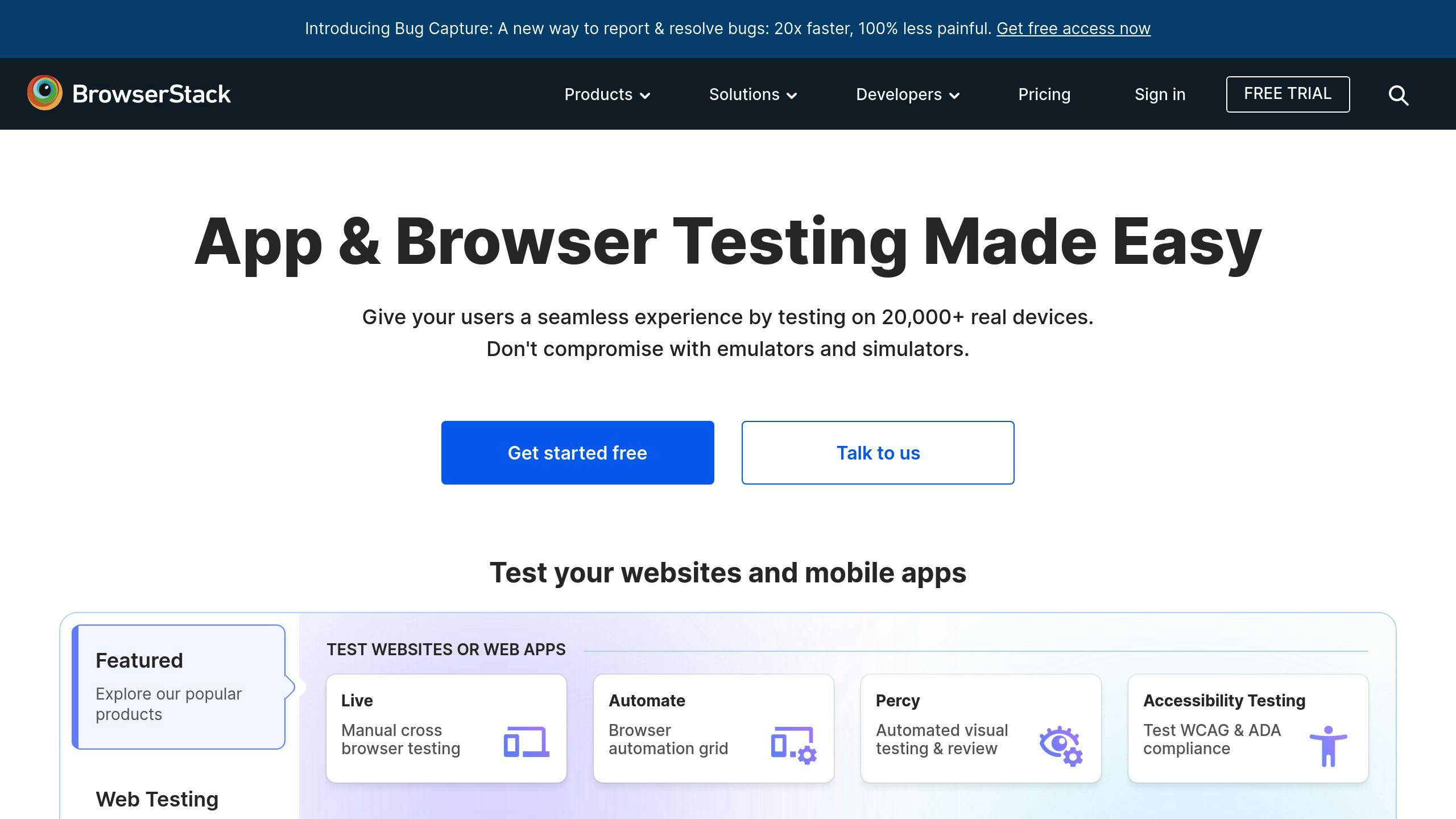AI test management tools are transforming software testing by automating complex tasks, improving efficiency, and enhancing software quality. Here's a quick overview of the 8 key features these tools offer:
- Test Case Prioritization: AI ranks test cases based on risk factors like code changes and defect density.
- Defect Prediction: Machine learning predicts potential software issues before they occur.
- Real-Time Data Analysis: Immediate insights into testing outcomes for faster decision-making.
- Automated Test Reports: AI-generated reports highlight patterns and provide actionable insights.
- AI-Driven Test Case Creation: Automatically generate test cases based on historical data and user behavior.
- Self-Healing Automation: Fix broken test scripts automatically as applications evolve.
- Test Environment Management: Automate setup, scaling, and monitoring of test environments.
- Continuous Testing Support: Seamless integration with CI/CD pipelines for ongoing quality assurance.
Quick Comparison
Here’s how some top AI tools stack up:
| Feature | BrowserStack | ReportPortal | PractiTest | Testim |
|---|---|---|---|---|
| Test Case Prioritization | AI-based | ML-based | Test Value Score | Smart test selection |
| Defect Prediction | AI-driven insights | Root cause analysis | Basic anomaly detection | AI failure detection |
| Real-Time Analytics | Comprehensive | Real-time monitoring | Custom reporting | Interactive analytics |
| Self-Healing Automation | Yes | Limited | No | Yes - Smart locators |
| Test Environment Management | Cloud infrastructure | Basic controls | Integration support | Cloud and local |
| Continuous Testing Support | Full CI/CD integration | Pipeline support | Basic integration | DevOps integration |
AI-powered tools like BrowserStack, ReportPortal, PractiTest, and Testim are reshaping how testing teams work. Choose the one that aligns with your needs based on integration, scalability, and AI features.
BrowserStack Test Management Overview

1. Test Case Prioritization
Test case prioritization is a standout feature of AI-powered test management tools. These tools use advanced algorithms to rank test cases based on factors like code churn, defect density, and customer usage patterns.
For instance, when critical components like payment systems undergo changes, AI tools automatically push related test cases to the top of the list. This ensures high-risk areas are thoroughly validated. In an e-commerce platform, if updates affect payment processing, the system prioritizes those test cases, safeguarding essential functions [5].
Machine learning plays a big role here. By analyzing historical data, it fine-tunes the prioritization process over time, improving the accuracy of test selection based on past outcomes [3]. This means teams can consistently focus on the most important areas.
When paired with other AI features, the impact grows. For example, integrating test prioritization with defect prediction tools allows the system to highlight tests in areas likely to have issues. This proactive approach helps catch potential problems early, reducing the chances of critical defects making it to production [3][4].
To make this work effectively, the tools need access to high-quality test data and seamless integration with CI/CD pipelines. With accurate historical data and real-time metrics, they can make better prioritization decisions [3]. By focusing on the most critical tests, teams can streamline their efforts and prepare for other AI-driven capabilities like real-time analytics and defect prediction.
2. Predicting Defects
AI-driven defect prediction is changing the game for test management tools, helping teams spot potential issues before they hit production. By using machine learning algorithms, these tools analyze various data points - like past defect trends, code changes, and user behavior - to flag possible software failures early on.
For example, AI tools can evaluate recent code changes to identify high-risk areas. If updates impact critical components such as authentication systems or database operations, the tool can automatically mark these areas for extra testing attention [5].
These machine learning models improve over time, learning from past results to become more precise in predicting defects. This means teams can better focus their testing efforts on areas that matter most [3]. By relying on real-world data and patterns, testing resources are used more efficiently.
AI-powered tools also work well with CI/CD pipelines, offering real-time insights during development. This integration allows teams to:
- Spot potential issues early in the process
- Prioritize testing based on risk levels
- Automatically assess how code changes impact the software
- Track recurring defect patterns
That said, the success of defect prediction depends on having high-quality data and strong system integration [3]. It also enhances test case prioritization by narrowing the focus to high-risk areas, making testing strategies more effective overall [5][3].
To measure how well defect prediction works, teams can monitor metrics like reduced defect density and improved test coverage [5]. This proactive approach not only cuts down on production failures but also ensures resources are used wisely, solving some of the biggest challenges in modern software testing.
3. Real-Time Data Analysis
Real-time analytics plays a key role in AI-driven test management, allowing teams to act on insights as they happen and maintain consistent quality. These tools process and interpret test data immediately, changing the way teams monitor and respond to testing outcomes.
For example, BrowserStack's Test Observability processes test data instantly to identify issues and improve stability. Similarly, ReportPortal helps by analyzing patterns, spotting anomalies, and cutting down on false positives, which saves teams a lot of manual effort [1][4].
To stay effective, real-time analytics tools can adjust test priorities right away based on code changes [2]. When paired with defect prediction tools, they allow teams to act quickly on flagged high-risk areas, keeping software quality intact even during fast-paced development cycles.
Metrics like test coverage, reliability, issue resolution time, and false positive rates are crucial for evaluating the impact of real-time analytics. However, the effectiveness of these tools hinges on the quality of the data and how well the systems are integrated. Teams need a testing setup that supports continuous data collection and analysis while ensuring data accuracy for dependable insights.
These insights also feed directly into automated reporting, giving teams actionable data to make informed decisions.
4. Automated Test Reports
AI-powered automated test reports are changing the way teams analyze test results and make decisions based on data. These tools take raw test data and turn it into useful insights, cutting down on manual work and boosting efficiency.
For instance, tools like ReportPortal use AI to compile test results and spot failure patterns, helping teams tackle recurring issues effectively [4]. These reports go beyond simple pass/fail outcomes by offering features like real-time analytics, failure prediction, and customizable dashboards. Together, these capabilities enable faster and smarter decision-making.
When paired with CI/CD pipelines, automated reporting offers specific advantages for analyzing test results:
- Instant feedback on whether a release is ready
- Automated checks to ensure quality standards
- Recognition of patterns in recurring failures
- Unified metrics from various testing platforms
Platforms like BrowserStack show how automated reporting can seamlessly integrate with existing test setups, allowing teams to assess release quality quickly [1][4]. However, for these tools to work well, it’s crucial to maintain clean test data and ensure proper system integration [3].
The best reports focus on the metrics that matter most - those that directly influence product quality and testing efficiency [4]. By bringing these insights together, teams can fine-tune their testing strategies while keeping up with the fast pace of development.
With automated reports offering clear insights, the next logical step is to use AI for creating and refining test cases, further streamlining the testing process.
sbb-itb-cbd254e
5. AI-Driven Test Case Creation
AI-driven test case creation is transforming test management by using machine learning to automatically produce detailed test scenarios, cutting down on manual work. This has become increasingly important as software grows more complex and release timelines shrink.
Modern AI testing tools create test cases by analyzing multiple data sources, such as:
- Code changes and their potential impact
- Historical test data trends
- User interaction patterns
- Recurring defect areas
- Application usage statistics
Platforms like TestSigma showcase how AI can revolutionize test case generation. By examining frequent code updates and identifying areas prone to issues, these tools focus on high-risk functionalities. For example, AI can create test cases for critical workflows like checkout processes, covering different payment and fulfillment scenarios thoroughly [5][3].
"AI-powered testing tools can help teams identify high-risk areas of the application and prioritize testing efforts accordingly, leading to improved defect detection and prevention." - Frugal Testing [3]
The effectiveness of AI-driven test case creation depends on clean historical data and smooth integration with existing systems. When paired with defect prediction and prioritization, these AI-generated test cases provide broad coverage while concentrating on the most vulnerable areas [3].
This approach shines in continuous testing setups, where AI adjusts test cases to match evolving code and requirements. It also addresses flaky tests - those with inconsistent results - by analyzing execution data to develop more reliable tests [3].
To get the most out of this technology, teams should prioritize maintaining high-quality training data and regularly assess how well the AI-generated test cases perform. This ensures the tests stay relevant and effective throughout the development cycle.
With workflows streamlined by AI-driven test case creation, the next frontier involves making these tests adaptable through self-healing features.
6. Self-Healing Test Automation
Self-healing test automation leverages AI to automatically detect and fix broken scripts. This minimizes maintenance efforts and ensures continuous testing, even in fast-changing environments. Modern platforms adjust test scripts to application updates, keeping them reliable without requiring manual fixes [1].
Unlike traditional automation, self-healing tools actively respond to changes in the application, reducing the need for frequent script updates. This is particularly helpful for teams working with interfaces that change often.
The process involves mechanisms that identify elements, manage dynamic loading, and update scripts in real-time as applications evolve. Teams can start by applying self-healing to unstable tests, cutting down on failures caused by dynamic changes in the application.
For effective implementation, it’s important to integrate self-healing automation into your existing testing frameworks. This approach helps maintain the accuracy and reliability of tests.
Here are a few critical factors to consider for successful self-healing automation:
- Data Quality: Make sure your system has access to reliable historical test data.
- Integration Points: Confirm compatibility with your current testing framework.
- Monitoring: Regularly evaluate self-healing performance to maintain consistency.
Self-healing test automation becomes even more powerful when paired with other AI-driven testing tools. Together, they create a testing system that handles complex scenarios while keeping manual intervention to a minimum. With stable tests in place, the next step is managing test environments effectively to ensure smooth workflows.
7. Managing Test Environments
AI-driven tools have transformed how teams manage testing setups and configurations. These modern solutions simplify the process of creating, maintaining, and scaling test environments, cutting down on manual work and saving time.
Today's AI testing platforms automate tasks like setting up environments and managing configurations. This includes deploying test data and ensuring all dependencies are properly aligned, drastically reducing the need for hands-on effort.
Another standout feature is how AI tools monitor and sync environments. They can spot and address issues before they cause problems, keeping testing smooth and reliable throughout development.
Here’s what makes AI-powered test environment management so effective:
- Smart Resource Management: AI dynamically adjusts resources based on testing needs, ensuring efficient usage while continuously monitoring environment health.
- Automated Data Handling: AI takes care of generating and managing test data, including anonymizing sensitive information to protect privacy.
To implement this effectively, teams should:
- Keep test data accurate and up-to-date
- Ensure the tools integrate well with existing testing frameworks
- Monitor metrics like setup time and error rates
Start small by automating stable, frequently-used environments. Once the process is reliable, expand to more complex setups. This gradual approach reduces risks and builds trust in the system.
8. Continuous Testing Support
AI-driven test management tools are changing the game for continuous testing by automating tasks, integrating seamlessly with development pipelines, and addressing issues early. Tools like BrowserStack handle test creation and streamline environment setup, while ReportPortal provides real-time updates and predictive root cause analysis to keep development cycles running smoothly [1][4].
AI brings two standout capabilities to continuous testing:
- Smart Test Orchestration: Automatically schedules and runs tests based on code changes and risk levels.
- Intelligent Resource Allocation: Dynamically adjusts computing resources to improve test execution.
To make the most of AI-powered continuous testing, teams should:
- Focus on Critical Paths: Start by applying AI to the most essential testing workflows.
- Track Metrics: Monitor key indicators like test coverage and reliability to gauge progress.
- Integrate Early: Introduce AI testing tools at the start of the development process.
AI tools also tackle persistent issues like flaky tests. These solutions can automatically spot inconsistent test behavior and rerun tests with minimal input from developers, cutting down on debugging time [1]. This allows teams to prioritize real problems instead of wasting time on false positives.
With features like immediate insights, early issue detection, and efficient resource use, AI-powered continuous testing enhances development cycles. Combined with tools for real-time analytics and environment management, it creates a robust testing ecosystem that supports fast, high-quality development [1][4].
Comparison Table
Let's break down how top AI test management tools stack up, so you can find the best match for your testing requirements.
| Feature | BrowserStack | ReportPortal | PractiTest | Testim |
|---|---|---|---|---|
| Test Case Prioritization | AI-based prioritization | ML-based prioritization | Test Value Score system | Smart test selection |
| Defect Prediction | AI-driven defect insights | Root cause analysis | Basic anomaly detection | AI failure detection |
| Real-Time Analytics | Comprehensive dashboard | Real-time monitoring | Custom reporting | Interactive analytics |
| Self-Healing Automation | Yes - Auto maintenance | Limited | No | Yes - Smart locators |
| Test Environment Management | Cloud infrastructure | Basic controls | Integration support | Cloud and local |
| Continuous Testing Support | Full CI/CD integration | Pipeline support | Basic integration | DevOps integration |
| Pricing Model | Usage-based | Open-source core | Per user/month | Enterprise pricing |
Key Features of Each Platform
- BrowserStack: Stands out with AI-driven test maintenance and a strong cloud infrastructure, making it excellent for cross-platform testing [1].
- ReportPortal: Known for its real-time analytics and root cause analysis, this tool is perfect for teams that prefer open-source solutions [4].
- PractiTest: Focuses on reducing execution time without sacrificing quality by using its Test Value Score system for prioritizing tests.
- Testim: Simplifies maintenance with self-healing test scripts, leveraging ML-powered automation for smarter testing.
Factors to Consider When Choosing
When evaluating these tools, think about:
- How well they integrate with your current tech stack
- Whether they can handle your testing volume as it scales
- Budget constraints and pricing models
- The level of AI sophistication your team requires
- Your team's expertise and the learning curve for each tool
Each tool has strengths and weaknesses. Some excel in specific areas but may fall short in others. Focus on your team's priorities and workflows to make the right choice. These AI-driven features tackle unique testing challenges, helping you align your tools with your objectives.
Conclusion
AI test management tools have reshaped software testing by making it faster, more dependable, and highly precise. The eight features highlighted earlier form the backbone of today's advanced testing capabilities.
These tools tackle major challenges like time-consuming manual processes, inflexible workflows, and the need to catch defects early. For example, healthcare organizations leveraging AI-driven testing have enhanced patient data security checks while cutting down testing time [5]. By blending intelligent automation with predictive insights, these tools create a testing environment that surpasses the limits of older methods.
When choosing a tool, focus on how well it integrates with your current systems, its ability to grow with your needs, the level of AI sophistication it offers, and how easily your team can adopt it. Whether you go for BrowserStack's cloud-based infrastructure or ReportPortal's open-source analytics, pick a tool that aligns with your specific requirements [1][4]. Key factors to keep in mind include:
- How seamlessly it works with your existing tools
- Its ability to scale as your testing needs expand
- The depth of AI capabilities needed for your projects
- Your team’s readiness to learn and adapt
AI-powered solutions are shaping the future of software testing, enabling faster and higher-quality software delivery in an increasingly competitive world. By adopting these tools, you’re not just improving your testing process - you’re setting the stage for better, more efficient outcomes.



